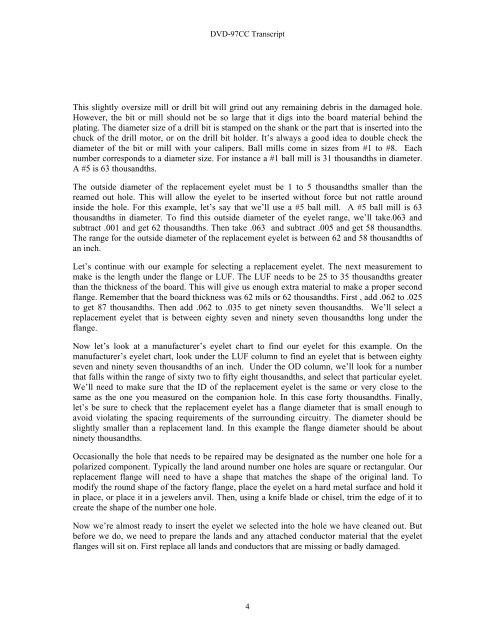Transcript - IPC Training Home Page
Transcript - IPC Training Home Page
Transcript - IPC Training Home Page
You also want an ePaper? Increase the reach of your titles
YUMPU automatically turns print PDFs into web optimized ePapers that Google loves.
DVD-97CC <strong>Transcript</strong>This slightly oversize mill or drill bit will grind out any remaining debris in the damaged hole.However, the bit or mill should not be so large that it digs into the board material behind theplating. The diameter size of a drill bit is stamped on the shank or the part that is inserted into thechuck of the drill motor, or on the drill bit holder. It’s always a good idea to double check thediameter of the bit or mill with your calipers. Ball mills come in sizes from #1 to #8. Eachnumber corresponds to a diameter size. For instance a #1 ball mill is 31 thousandths in diameter.A #5 is 63 thousandths.The outside diameter of the replacement eyelet must be 1 to 5 thousandths smaller than thereamed out hole. This will allow the eyelet to be inserted without force but not rattle aroundinside the hole. For this example, let’s say that we’ll use a #5 ball mill. A #5 ball mill is 63thousandths in diameter. To find this outside diameter of the eyelet range, we’ll take.063 andsubtract .001 and get 62 thousandths. Then take .063 and subtract .005 and get 58 thousandths.The range for the outside diameter of the replacement eyelet is between 62 and 58 thousandths ofan inch.Let’s continue with our example for selecting a replacement eyelet. The next measurement tomake is the length under the flange or LUF. The LUF needs to be 25 to 35 thousandths greaterthan the thickness of the board. This will give us enough extra material to make a proper secondflange. Remember that the board thickness was 62 mils or 62 thousandths. First , add .062 to .025to get 87 thousandths. Then add .062 to .035 to get ninety seven thousandths. We’ll select areplacement eyelet that is between eighty seven and ninety seven thousandths long under theflange.Now let’s look at a manufacturer’s eyelet chart to find our eyelet for this example. On themanufacturer’s eyelet chart, look under the LUF column to find an eyelet that is between eightyseven and ninety seven thousandths of an inch. Under the OD column, we’ll look for a numberthat falls within the range of sixty two to fifty eight thousandths, and select that particular eyelet.We’ll need to make sure that the ID of the replacement eyelet is the same or very close to thesame as the one you measured on the companion hole. In this case forty thousandths. Finally,let’s be sure to check that the replacement eyelet has a flange diameter that is small enough toavoid violating the spacing requirements of the surrounding circuitry. The diameter should beslightly smaller than a replacement land. In this example the flange diameter should be aboutninety thousandths.Occasionally the hole that needs to be repaired may be designated as the number one hole for apolarized component. Typically the land around number one holes are square or rectangular. Ourreplacement flange will need to have a shape that matches the shape of the original land. Tomodify the round shape of the factory flange, place the eyelet on a hard metal surface and hold itin place, or place it in a jewelers anvil. Then, using a knife blade or chisel, trim the edge of it tocreate the shape of the number one hole.Now we’re almost ready to insert the eyelet we selected into the hole we have cleaned out. Butbefore we do, we need to prepare the lands and any attached conductor material that the eyeletflanges will sit on. First replace all lands and conductors that are missing or badly damaged.4
















